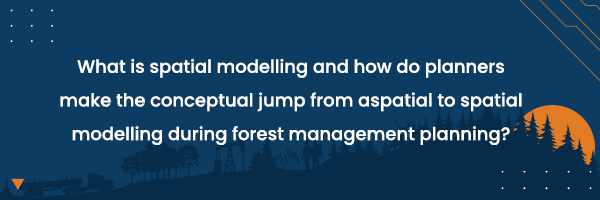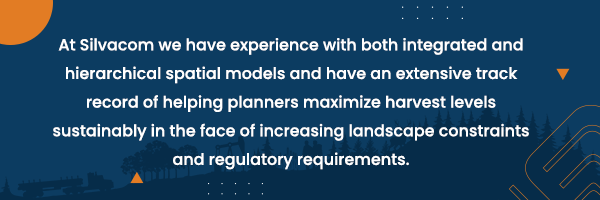Across Canada, there is a need to verify the long-term sustainability of forest management plans. This has typically required planners to demonstrate that their forest management plans provide long-term and steady fibre supply while complying with various fibre and non-fibre constraints over a projected planning horizon of between 100 to 200 years. While this is often done aspatially (without consideration to spatial planning constraints or harvest block scheduling) many planners are beginning to plan using spatial models to both comply with provincial regulations and improve planning efficiency. This begs the question: what is spatial modelling and how do planners make the conceptual jump from aspatial to spatial modelling during forest management planning?

Hierarchical Spatial Models
The easy answer is that spatial modelling picks up where aspatial models leave off. That is to say that once an aspatial model has determined what is to be scheduled, a spatial model determines where the harvest should be scheduled. Linking aspatial and spatial modelling in this way often works well within existing planning standards as the aspatial-to-spatial planning phases align with strategic-to-tactical planning phases. Once the more complex strategic phase has been solved aspatially, the harvest schedule that is produced from that phase can then be allocated (solved) spatially. Treating the planning process as hierarchical in this way is a pragmatic solution that allows even the most complex of forest management issues to be solved.
Integrated Spatial Models
However, there are cases where spatial constraints need to be considered for the entire planning horizon. In these cases, modelling is spatial throughout the length of the planning horizon and aspatial modelling is no longer a consideration. This approach integrates strategic, tactical, and operational planning into one modelling solution which provides a spatially explicit harvest schedule for the length of the planning horizon. This provides consistent and reliable results as, unlike the hierarchical approach, the strategic planning phase is solved with consideration to tactical and operational objectives. This prevents operational-level decisions from violating any of the long-term strategic objectives.
Which Spatial Model Do I Choose?
 Before determining which approach to take for a forest management plan, planners should first consider their needs including the forest composition, silviculture regimes, and management goals. As a general rule, the larger and more complex the forest makeup, the larger and more complex the forest management model will inherently become. Some questions planners should ask themselves before choosing a spatial modelling approach are:
Before determining which approach to take for a forest management plan, planners should first consider their needs including the forest composition, silviculture regimes, and management goals. As a general rule, the larger and more complex the forest makeup, the larger and more complex the forest management model will inherently become. Some questions planners should ask themselves before choosing a spatial modelling approach are:
- What timeframe needs to be modelled? Typically, several rotations are required at the strategic level to demonstrate sustainability. Each rotation adds an exponential number of choices for a model to consider which may be limited by computational power, especially in integrated spatial models.
- Does the entire planning horizon need to be spatial? If using a 200-year planning horizon, is there value in knowing what blocks will be harvested in 100 or 200 years? Or is 50 years’ worth of blocks sufficient?
- Is the goal to model both strategically and operationally at the same time? In many jurisdictions, strategic and tactical/operational planning are handled separately.
- How many management constraints need to be modelled and are any of them at odds with each other? Integrated and hierarchical models handle management constraint trade-offs differently.
- Is your forest stratified at the stratum/forest type level, or at an individual stand-level? Volumes for individual stands can negate some of the benefits of hierarchical modelling.
Complexity and Integrated Spatial Models
Forests with a large number of stands and forest types or that are subject to a variety of potential silvicultural systems present challenges for integrated spatial models due to the sheer number of potential harvest and silvicultural choices the model must consider. Adding various management objectives to the model compounds this problem. Fully spatial, integrated models generally handle constraints and targets in a ‘soft’ way, where the model is never totally prohibited from violating the constraint but is instead incentivized into meeting it. Planners may find that in management problems where there are many management objectives necessitating constraints that integrated spatial models are not capable of balancing all considerations and still maintaining acceptable harvest rates.
Hierarchical Spatial Model and Optimization
Hierarchical spatial models thrive in the face of forest complexity. Solving at the strategic level aspatially allows planners to meet ‘hard’ management constraints and the optimization approach used by aspatial models ensures that an optimal solution is found regardless of forest composition, silvicultural regime, or the number of forest management objectives. However, assigning a spatial harvest sequence to an aspatial harvest schedule can result in unexpected harvest patterns and results that are inconsistent with the aspatial solution. This part of hierarchical spatial modelling requires that planners critically assess what spatial components need to be part of the solution so that an optimal spatial sequence can be generated.
Why Silvacom?
 At Silvacom we have experience with both integrated and hierarchical spatial models and have an extensive track record of helping planners maximize harvest levels sustainably in the face of increasing landscape constraints and regulatory requirements. With the expected move to enhanced forest inventories (EFI), the complexity of forest management models will only increase. Land managers and planners need to understand all the options surrounding spatial models to ensure they continue to produce effective management solutions.
At Silvacom we have experience with both integrated and hierarchical spatial models and have an extensive track record of helping planners maximize harvest levels sustainably in the face of increasing landscape constraints and regulatory requirements. With the expected move to enhanced forest inventories (EFI), the complexity of forest management models will only increase. Land managers and planners need to understand all the options surrounding spatial models to ensure they continue to produce effective management solutions.
If you require a turn-key spatial modelling solution or simply want to learn more about the different spatial modelling options and the applications to your forest management planning challenge, contact us today to get your spatial modelling project started right!







